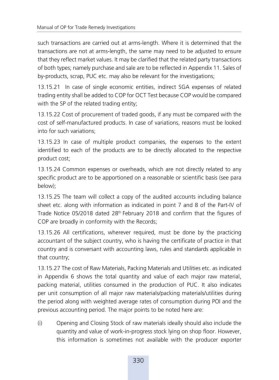Page 353 - Manual Of Operating Practices For Trade Remedy Investigations
P. 353
Manual of OP for Trade Remedy Investigations
such transactions are carried out at arms-length. Where it is determined that the
transactions are not at arms-length, the same may need to be adjusted to ensure
that they reflect market values. It may be clarified that the related party transactions
of both types; namely purchase and sale are to be reflected in Appendix 11. Sales of
by-products, scrap, PUC etc. may also be relevant for the investigations;
13.15.21 In case of single economic entities, indirect SGA expenses of related
trading entity shall be added to COP for OCT Test because COP would be compared
with the SP of the related trading entity;
13.15.22 Cost of procurement of traded goods, if any must be compared with the
cost of self-manufactured products. In case of variations, reasons must be looked
into for such variations;
13.15.23 In case of multiple product companies, the expenses to the extent
identified to each of the products are to be directly allocated to the respective
product cost;
13.15.24 Common expenses or overheads, which are not directly related to any
specific product are to be apportioned on a reasonable or scientific basis (see para
below);
13.15.25 The team will collect a copy of the audited accounts including balance
sheet etc. along with information as indicated in point 7 and 8 of the Part-IV of
Trade Notice 05/2018 dated 28 February 2018 and confirm that the figures of
th
COP are broadly in conformity with the Records;
13.15.26 All certifications, wherever required, must be done by the practicing
accountant of the subject country, who is having the certificate of practice in that
country and is conversant with accounting laws, rules and standards applicable in
that country;
13.15.27 The cost of Raw Materials, Packing Materials and Utilities etc. as indicated
in Appendix 6 shows the total quantity and value of each major raw material,
packing material, utilities consumed in the production of PUC. It also indicates
per unit consumption of all major raw materials/packing materials/utilities during
the period along with weighted average rates of consumption during POI and the
previous accounting period. The major points to be noted here are:
(i) Opening and Closing Stock of raw materials ideally should also include the
quantity and value of work-in-progress stock lying on shop floor. However,
this information is sometimes not available with the producer exporter
330

